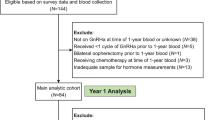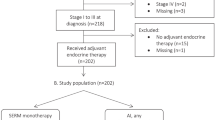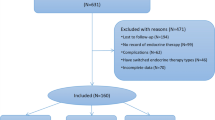Abstract
Anti-oestrogen therapy is being used in an attempt to prevent breast cancer but no intermediate end points of the effect of tamoxifen on the normal breast are available. Therefore, the purpose of this study was to develop a physiological measure of oestrogen action on the breast. We measured oestrogen-stimulated and -inhibited proteins in breast secretions from women on and off anti-oestrogen therapy. Two oestrogen-stimulated proteins (pS2 and cathepsin D) and oestrogen-inhibited proteins (CP15, gross cystic disease fluid protein 15; Apo ,: apolipoprotein D) were measured. Premenopausal women had significantly higher pS2 and cathepsin D in association with lower Apo D and CP15 secretion levels compared to post-menopausal women. Sequential nipple aspirates from women treated with the luteinizing hormone releasing hormone agonist goserelin (n = 9), tamoxifen (n = 9) and hormone replacement therapy (HRT) (n = 26) were measured. Following treatment with goserelin, median nipple secretion levels of pS2 fell (P< 0.02) and Apo D and CP15 rose significantly (P< 0.03 and P< 0.05 respectively). Similar changes were seen on tamoxifen therapy but not in untreated control women. Treatment with HRT resulted in a rise of pS2 (P< 0.001) and a fall in Apo D (P< 0.05). Measurement of pS2 and Apo D in nipple aspirates may prove useful intermediate end point of breast responsiveness to anti-oestrogens. © 2000 Cancer Research Campaign
Similar content being viewed by others
Article PDF
Change history
16 November 2011
This paper was modified 12 months after initial publication to switch to Creative Commons licence terms, as noted at publication
References
Bergkvist L, Adami HO, Persson I, Hoover R and Schairer C (1989) Risk of breast cancer after estrogen and estrogen-progestin replacement. N Engl J Med 321: 293–297
Brown AMC, Jeltsch JM, Roberts M and Chambon P (1984) Activation of pS2 transcription is a primary response to oestrogen in the human breast cancer cell line MCF7. Proc Natl Acad Sci USA 81: 6344–6348
Bulbrook RD, Hayward JL, Wang DY, Thomas BS, Clark GM, Allen DS and Moore JW (1986) Identification of women at high risk of breast cancer. Breast Cancer Res Treat 7: 5–10
Cavailles V, Augereau P, Garcia M and Rochefort H (1988) Estrogens and growth factors induce the mRNA of the 52K-pro-cathepsin D secreted by breast cancer cells. Nucleic Acids Res 16: 1903–1919
Cavailles V, Garcia M and Rochefort H (1989) Regulation of Cathepsin D and pS2 gene expression by growth factors in MCF7 human breast cancer cells. Mol Endocrinol 3: 552–558
Chalbos D, Haagensen D, Parish T and Rochefort H (1987) Identification and androgen regulation of two proteins released by T47D human breast cancer cells. Cancer Res 47: 2878–2792
Early Breast Cancer Trialists Collaborative Group (1992) Systemic treatment of early breast cancer by hormonal, cytotoxic or immune therapy. Lancet 339: 1–15
Ernster VL, Wrensch MR, Petrakis NL, King EB, Miike R, Murai J, Goodson WHIII and Siiteri PK (1987) Benign and malignant breast disease: initial study results of serum and breast fluid analyses of endogenous estrogens. J Natl Cancer Inst 79: 949–960
Haagensen DE, Dilley WG, Mazoujian G and Wells SA (1990) Review of GCDFP-15. Ann NY Acad Sci 586: 161–173
Harding C, Howell A and Bundred NJ (1996). Proceedings of the Benign Breast Disease Meeting, July 1995, Parthenon: London
Hunt K, Vessey M, Mcpherson K and Coleman M (1987) Long-term surveillance of mortality and cancer incidence in women receiving hormone replacement therapy. Br J Obs Gynecol 94: 620–635
Key TJA and Pike MC (1988) The role of oestrogens and progestagens in the epidemiology and prevention of breast cancer. Eur J Cancer Clin Oncol 24: 29–43
Lippsett MB and Bergenske DM (1960) Lack of effect of human growth hormone and ovine prolactin on cancer in Man. Cancer Res 20: 1172–1178
MacMahon B, Cole P and Brown JB (1986) Urine oestrogens, frequency of ovulation and breast cancer risk: case control study in premenopausal women. J Natl Cancer Inst 77: 613–616
Petrakis NL (1986) Physiologic, biochemical and cytological aspects of nipple aspirate fluid. Breast Cancer Res Treat 8: 7–19
Petrakis NL, Ernster VL, Sacks ST, King EB, Schweltzer RJ, Hunt TK and King MC (1981) Epidemiology of breast fluid secretion: association with breast risk factors and cerumen type. J Natl Cancer Inst 67: 277–284
Petrakis NL, Wrensch MR, Ernster VL, Miike R, Mirai J, Simberg N and Sitteri PK (1987) Influence of pregnancy and lactation on serum and breast fluid oestrogen levels: implications for breast cancer risk. Int J Cancer 40: 587–591
Petrakis NL, Lowenstein JM, Wiencke JK, Lee MM, Wrensch MR, King EB, Hilton JF and Miike R (1993) Gross cystic disease fluid protein in nipple aspirates of breast fluid of Asian and non-Asian women. Cancer Epidemiol Biomarkers Prev 2: 573–579
Potten CS, Watson RJ, Williams GT, Tickle S, Roberts SA, Harris M and Howell A (1988) The effect of age and menstrual cycle upon proliferative activity of the normal human breast. Br J Cancer 58: 163–170
Rajah TT, Dunn T and Pento JT (1996) The influence of antioestrogens on pS2 and cathepsin D mRNA induction in MCF-7 breast cancer cells. Anticancer Res 16: 837–842
Sanchez LM, Visozo F, Diez-Itza I and Lopez-Otin C (1992) Identification of the major protein components in breast secretions from women with benign and malignant breast diseases. Cancer Res 52: 95–100
Simard J, Dauvois S, Haagensen D, Levesque C, Merand Y and Labrie F (1990) Regulation of progesterone-binding breast cyst protein GCDFP 24 secretion by oestrogens and androgens in human breast cancer cells: a new marker of steroid action in breast cancer. Endocrinology 126: 3223–3231
Weaver I, Christine A, Springer PA and Katzenellenbogen B (1988) Regulation of pS2 gene expression by affinity labelling and reversibly binding oestrogens and antioestrogens. Mol Endocrinol 2: 936–945
Wrensch MR, Petrakis NL, Gruenke LD, Ernster VL, Miike R and King EB Hauck (1990) Factors associated with obtaining nipple aspirate fluid: analysis of 1428 women and literature review. Breast Cancer Res Treat 15: 39–51
Zumoff B (1988) Hormonal profiles in women with breast cancer. Anticancer Res 8: 627–636
Author information
Authors and Affiliations
Rights and permissions
From twelve months after its original publication, this work is licensed under the Creative Commons Attribution-NonCommercial-Share Alike 3.0 Unported License. To view a copy of this license, visit http://creativecommons.org/licenses/by-nc-sa/3.0/
About this article
Cite this article
Harding, C., Osundeko, O., Tetlow, L. et al. Hormonally-regulated proteins in breast secretions are markers of target organ sensitivity. Br J Cancer 82, 354–360 (2000). https://doi.org/10.1054/bjoc.1999.0926
Received:
Revised:
Accepted:
Published:
Issue date:
DOI: https://doi.org/10.1054/bjoc.1999.0926
Keywords
This article is cited by
-
Protein Biomarkers for Breast Cancer Risk Are Specifically Correlated with Local Steroid Hormones in Nipple Aspirate Fluid
Hormones and Cancer (2016)
-
Apolipoprotein D predicts adverse outcome in women ≥70 years with operable breast cancer
Breast Cancer Research and Treatment (2009)
-
Cytosolic levels of TFF1/pS2 in breast cancer: their relationship with clinical–pathological parameters and their prognostic significance
Breast Cancer Research and Treatment (2006)



